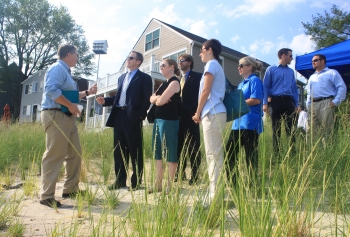Eric Schwaab, NOAA’s Assistant Administrator for Fisheries, was in Annapolis Thursday with U.S. Senator Ben Cardin, Chesapeake Bay Trust Executive Director Jana Davis, Maryland Department of Environment Secretary Dr. Robert Summers, Maryland Department of Natural Resources Secretary John Griffin and others to announce $800,000 in federal, state and private funding to create “living shorelines” on Chesapeake Bay.
Shorelines, like those in the bay, are often stabilized with hard materials, such as bulkheads and seawalls. Ironically, these structures often increase the rate of coastal erosion, and provide little habitat for fish and wildlife. Living shorelines mimic nature by using plants, sand, and sometimes rock to stabilize banks while maintaining and improving valuable fish and wildlife habitat.
Sixteen homeowner associations, nonprofit organizations, and municipalities in Maryland and Virginia have been selected to be part of the program to develop living shorelines and increase public understanding of the technique.
“In order to fully restore our great Chesapeake Bay, we are going to have to employ a multitude of techniques, including the creation of living shorelines,” said Senator Cardin, a longtime supporter of bay restoration.
“Living shorelines are a win-win solution to shoreline erosion. They replace hardened structures with more natural, vegetated shorelines that not only prevent erosion and protect shorelines, but also provide habitat for fish and wildlife,” said Schwaab.
NOAA was one of the founding partners of the living shoreline program, which to date has funded 68 projects, created 28,000 linear feet of living shoreline—the length of the Bay Bridge!—and 18 acres of wetland habitat. NOAA and the Chesapeake Bay Trust each contributed $275,000 to the $800,000 award; the Maryland Department of the Environment contributed about $200,000; and the Maryland Department of Natural Resources contributed $50,000.



Post new comment